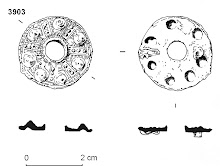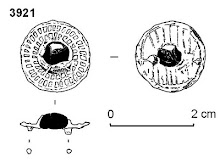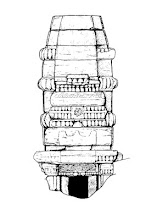 | |
| Camp at contemporary temple site at Dullu |
The project had its origins a few years earlier, Tim Harward –my father- had photographed a series of monuments during a visit to Lake Rara in west Nepal to investigate potential new trekking routes. I encouraged him to talk to archaeologists who had worked in Nepal, leading to talks with Chris Evans of the Cambridge Archaeology Unit, and Tim Williams of the Institute of Archaeology, UCL, and grant funding from National Geographic for a reconnaissance expedition in 1998.
We were partly following in the footsteps of the Fascist Italian archaeologist Guiseppi Tucci, but largely we were on our own -following leads from villagers as to the whereabouts of temples, dharamsala (guest houses), waterpoints and tanks, and the pillar stones that the Khasa Malla used to mark battles and edicts. The pillar stones (Vir Stambha, or Hero Stones) are between 4 and 10 foot high, and are found across west Nepal and the neighbouring Indian areas of Garwahl and Kumaon. The pillar stones sometimes carry carvings of Buddhist motifs such as stupa or the sun and moon, depictions of mounted soldiers, and inscriptions including calendar dates and names and genealogies. Other pillar stones are similar to Hindu Stambha from northern India, with amalaka motifs and the geographical transition from Hindu to Buddhist motifs is one aspect that the project intended to study: two interlinked religions within one kingdom.
 |
| Pillar Stone at Tatopani with Buddhist Stupa motif |
 | |
| Temple at Parse Bada, reconstructed from field notes |
Work, family and civil war have prevented my return to west Nepal for 13 years, but finally it is time to return to the kingdom of the Khasa Malla to carry out a detailed evaluation of the southern part of the kingdom: the area around the Winter capital of Dullu, and the nearby town of Dailekh. This year’s work will aim to design and create a gazetteer of the surviving sites and monuments, evaluate any damage and threats, and assess the best methodologies for recording the monuments. Detailed recording work will be carried out on a range of monuments in order to test methodologies and assess logistics, practicalities and time-scales for future work, including how local Nepali archaeologists can take on the work, and how the local populations' interest in the Khasa Malla can be fostered.













